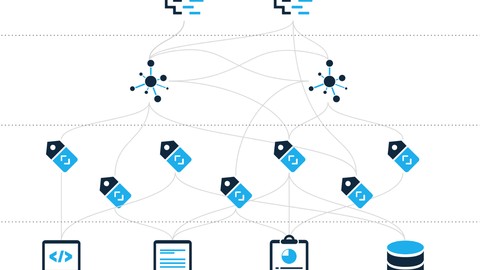
Metadata Management Fundamentals
Metadata Management Fundamentals, available at $39.99, has an average rating of 4.15, with 35 lectures, based on 237 reviews, and has 1055 subscribers.
You will learn about What is Metadata? Learn about the importance of Metadata to an Enterprise The Business Value of Metadata for an Enterprise Types of Metadata Real Time Use Case 1: How to fetch Metadata from different Data Layers of an Enterprise Data Warehouse? Real Time Use Case 2:How to fetch Metadata from different Data Layers of a Hybrid Enterprise Data Warehouse involving Big Data? How does the different data layers of an application connect via Metadata? What problems does the Metadata Management Solves? What business questions does the Metadata Management answer? What are Data Assets? What is Data Lineage? What is Data Stewardship? What are the different domains from which Metadata can be fetched and liked for trace-ability? How does Metadata Management relate to Data Management? This course is ideal for individuals who are All roles which involves and works with data on a daily basis from a Developer to the CDO or a CIO It is particularly useful for All roles which involves and works with data on a daily basis from a Developer to the CDO or a CIO.
Enroll now: Metadata Management Fundamentals
Summary
Title: Metadata Management Fundamentals
Price: $39.99
Average Rating: 4.15
Number of Lectures: 35
Number of Published Lectures: 35
Number of Curriculum Items: 35
Number of Published Curriculum Objects: 35
Original Price: $199.99
Quality Status: approved
Status: Live
What You Will Learn
- What is Metadata?
- Learn about the importance of Metadata to an Enterprise
- The Business Value of Metadata for an Enterprise
- Types of Metadata
- Real Time Use Case 1: How to fetch Metadata from different Data Layers of an Enterprise Data Warehouse?
- Real Time Use Case 2:How to fetch Metadata from different Data Layers of a Hybrid Enterprise Data Warehouse involving Big Data?
- How does the different data layers of an application connect via Metadata?
- What problems does the Metadata Management Solves?
- What business questions does the Metadata Management answer?
- What are Data Assets?
- What is Data Lineage?
- What is Data Stewardship?
- What are the different domains from which Metadata can be fetched and liked for trace-ability?
- How does Metadata Management relate to Data Management?
Who Should Attend
- All roles which involves and works with data on a daily basis from a Developer to the CDO or a CIO
Target Audiences
- All roles which involves and works with data on a daily basis from a Developer to the CDO or a CIO
Let’s get started with the basics of Metadata Management.
Setting up the Metadata Management initiative at the enterprise level serves a variety of purposes. Data Asset discovery, effective cataloging, identifying resources, defining them by criteria, bringing similar resources together and the most important of them all is to have a Self Service approach to the enterprise assets.
It also is an effective means of organizing enterprise data assets, which is the need of the hour considering the huge variety and volumes of data and new ways of doing business online. Typically, all the metadata is stored in documents or excel sheets which are not usually up to date just for the namesake and these documents do not really have what one needs. A more efficient way is to use metadata to define, build lineage, relationships and create trace-ability so that the enterprise data citizens can easily find the data, the systems in which the data resides and the owners or stewards of the data.
Investing in metadata management/development have a lot of benefits:
-
Simplify data discovery and history of the data with a record of content-rich data across the enterprise.
-
Most of the enterprises have to manage increasingly complex systems in various locations and on varied platforms. By managing metadata effectively, organizations can create an inventory of its data and learn about its transformation across the life cycle, along with the variety of meaning and formats, and locations of each data object.
-
Drive consistency through data reuse, to increase productivity and reduce time needed for project implementation.
-
A managed metadata environment serves as the most effective way to identify the appropriate data elements / objects needed for any use.
-
Metadata Management allows companies to retire unused storage, reducing costs, and reducing time that was spent in deciding among “possibly correct” variations of an attribute.
-
Retain staff knowledge that is lost when business rules, definitions and other forms of metadata are not documented. Often, business metadata remains only in the minds of certain employees. When these individuals leave the company, this knowledge disappears with them. Implementing an enterprise approach to managing metadata preserves this knowledge and reduces the risk of losing valuable contextual knowledge.
-
Increase confidence in the data delivered to business users. Tracking data lineage provides important context to business users. Profiling data in source systems by business data stewards and IT staff can resolve data errors, which will result in accurate, reliable, high-quality data presented in reports, queries and analytics.
-
Improve IT performance in development, impact analysis, data integration, change management, etc… All of these enhancements will enable greater cooperation between business and IT, and ultimately lower total costs of any systems initiative. Metadata helps IT understand what data exists, where it is located, and what it means, minimizing information complexity. The ability to assess the impact of potential changes based on improved knowledge of the data can help managers estimate project duration and resource costs more accurately.
Course Curriculum
Chapter 1: Introduction
Lecture 1: What is Metadata?
Lecture 2: Common Metadata Examples from our day to day work/activities
Lecture 3: Why do we need to manage Metadata?
Lecture 4: What questions does Metadata Management helps us to answer?
Lecture 5: What are the common Questions specific to an attribute in a real time project?
Lecture 6: How does Metadata help with the Business Processes and Procedures?
Lecture 7: How does Metadata help with the Regulations and compliance like GDPR and CCPA?
Chapter 2: Types of Metadata
Lecture 1: Introduction to different types of Metadata
Lecture 2: Business Metadata
Lecture 3: Technical Metadata
Lecture 4: Difference between Technical Metadata and Business Metadata
Lecture 5: Operational Metadata
Lecture 6: Governance Metadata
Lecture 7: Summary of different types of Metadata
Lecture 8: Descriptive, Structural and Administrative Metadata Types
Chapter 3: Metadata Origins in an Enterprise
Lecture 1: Where does Metadata exists in the Organization?
Chapter 4: Real Time Use Case : Using Enterprise Data Warehouse Applications
Lecture 1: The Architecture
Lecture 2: What is happening now at an Enterprise level?
Lecture 3: What are the common questions we get on a daily basis?
Lecture 4: Metadata Repository is the answer
Lecture 5: How do we access the Metadata Repository Tool?
Lecture 6: Self Service Metadata Management
Lecture 7: Data Lineage/ Data Traceability
Lecture 8: Relationships within Metadata
Lecture 9: Enterprise View of Metadata
Chapter 5: Real Time Use Case : How to fetch Metadata from BigData Tools and Technologies?
Lecture 1: The Hybrid BigData Warehouse Architecture
Lecture 2: Where to start the Metadata Ingestion?
Lecture 3: Metadata from the Source Layer
Lecture 4: Metadata from JSON format
Lecture 5: Metadata from Relational tools and technologies
Lecture 6: Metadata from HDFS Layer
Lecture 7: Metadata from EDW/Data Marts/Hive/Analytics Layer
Lecture 8: Metadata from Analytics/Reporting Layer
Lecture 9: Metadata from Data Science and Transformation Logic
Lecture 10: How does all the Metadata tie up?
Instructors
-
Sid Inf
Data/ETL Architect
Rating Distribution
- 1 stars: 2 votes
- 2 stars: 13 votes
- 3 stars: 37 votes
- 4 stars: 90 votes
- 5 stars: 95 votes
Frequently Asked Questions
How long do I have access to the course materials?
You can view and review the lecture materials indefinitely, like an on-demand channel.
Can I take my courses with me wherever I go?
Definitely! If you have an internet connection, courses on Udemy are available on any device at any time. If you don’t have an internet connection, some instructors also let their students download course lectures. That’s up to the instructor though, so make sure you get on their good side!
You may also like
- Top 10 Video Editing Courses to Learn in November 2024
- Top 10 Music Production Courses to Learn in November 2024
- Top 10 Animation Courses to Learn in November 2024
- Top 10 Digital Illustration Courses to Learn in November 2024
- Top 10 Renewable Energy Courses to Learn in November 2024
- Top 10 Sustainable Living Courses to Learn in November 2024
- Top 10 Ethical AI Courses to Learn in November 2024
- Top 10 Cybersecurity Fundamentals Courses to Learn in November 2024
- Top 10 Smart Home Technology Courses to Learn in November 2024
- Top 10 Holistic Health Courses to Learn in November 2024
- Top 10 Nutrition And Diet Planning Courses to Learn in November 2024
- Top 10 Yoga Instruction Courses to Learn in November 2024
- Top 10 Stress Management Courses to Learn in November 2024
- Top 10 Mindfulness Meditation Courses to Learn in November 2024
- Top 10 Life Coaching Courses to Learn in November 2024
- Top 10 Career Development Courses to Learn in November 2024
- Top 10 Relationship Building Courses to Learn in November 2024
- Top 10 Parenting Skills Courses to Learn in November 2024
- Top 10 Home Improvement Courses to Learn in November 2024
- Top 10 Gardening Courses to Learn in November 2024






















